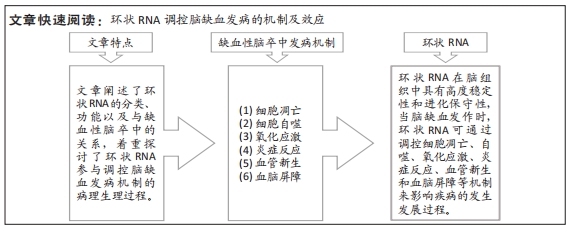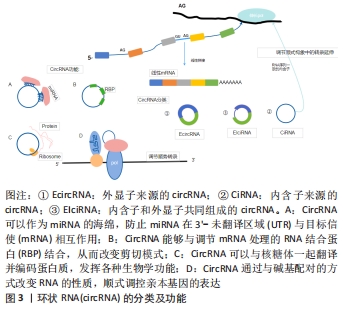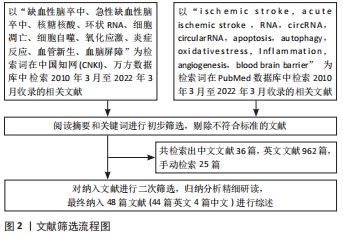[1] LI JY, LI QQ, SHENG R. The role and therapeutic potential of exosomes in ischemic stroke. Neurochem Int. 2021;151:105194.
[2] 张毅,冯康倪,陈鉴涛,等.非编码RNA在脑缺血再灌注损伤中的作用[J].中国病理生理杂志,2021,37(2):347-355.
[3] LI F, LI C, LI X, et al. Altered circular RNA expression profiles in the non-ischemic thalamus in focal cortical infarction mice. Aging. 2020; 12(13):13206-13219.
[4] JIANG Q, SU DY, WANG ZZ, et al. Retina as a window to cerebral dysfunction following studies with circRNA signature during neurodegeneration. Theranostics. 2021;11(4):1814-1827.
[5] DONG Z, DENG L, PENG Q, et al. CircRNA expression profiles and function prediction in peripheral blood mononuclear cells of patients with acute ischemic stroke. J Cell Physiol. 2020;235(3):2609-2618.
[6] ZUO L, ZHANG L, ZU J, et al. Circulating Circular RNAs as Biomarkers for the Diagnosis and Prediction of Outcomes in Acute Ischemic Stroke. Stroke. 2020;51(1):319-323.
[7] LI S, CHEN L, XU C, et al. Expression profile and bioinformatics analysis of circular RNAs in acute ischemic stroke in a South Chinese Han population. Sci Rep. 2020;10(1):10138.
[8] SALZMAN J, CHEN RE, OLSEN MN, et al. Cell-type specific features of circular RNA expression. PLoS Genet. 2013;9(9):e1003777.
[9] 黄纪,李瑞曦,徐军发.环状RNA在感染性疾病中的研究进展[J].医学研究生学报,2020,33(12):1320-1325.
[10] WANG Q, LIU X, ZHAO J, et al. Circular RNAs: novel diagnostic and therapeutic targets for ischemic stroke. Expert Rev Mol Diagn. 2020; 20(10):1039-1049.
[11] CHEN JN, ZHANG YN, TIAN LG, et al. Down-regulating Circular RNA Prkcsh suppresses the inflammatory response after spinal cord injury . Neural Regen Res. 2022;17(1):144-151.
[12] 卢志刚,杨昌明,孔祥辉,等. 醒脑开窍中药治疗脑缺血再灌注损伤作用机制的研究进展[J].中国实验方剂学杂志,2021,27(24):235-242.
[13] BOGUSZEWSKA-CZUBARA A, BUDZYNSKA B, SKALICKA-WOZNIAK K, et al. Perspectives and New Aspects of Metalloproteinases’ Inhibitors in the Therapy of CNS Disorders: From Chemistry to Medicine. Curr Med Chem. 2019;26(18):3208-3224.
[14] XU N, ZHANG Y, DOYCHEVA DM, et al. Adiponectin attenuates neuronal apoptosis induced by hypoxia-ischemia via the activation of AdipoR1/APPL1/LKB1/AMPK pathway in neonatal rats. Neuropharmacology. 2018;133:415-428.
[15] WANG H, LI Z, GAO J, et al. Circular RNA circPTK2 regulates oxygen-glucose deprivation-activated microglia-induced hippocampal neuronal apoptosis via miR-29b-SOCS-1-JAK2/STAT3-IL-1β signaling. Int J Biol Macromol. 2019;129:488-496.
[16] OHSHIRO K, CHEN J, SRIVASTAV J, et al. Alterations in TGF-β signaling leads to high HMGA2 levels potentially through modulation of PJA1/SMAD3 in HCC cells. Genes Cancer. 2020;11(1-2):43-52.
[17] CHE F, DU H, WEI J, et al. MicroRNA-323 suppresses nerve cell toxicity in cerebral infarction via the transforming growth factor-β1/SMAD3 signaling pathway. Int J Mol Med. 2019;43(2):993-1002.
[18] CHEN W, WANG H, FENG J, et al. Overexpression of circRNA circUCK2 Attenuates Cell Apoptosis in Cerebral Ischemia-Reperfusion Injury via miR-125b-5p/GDF11 Signaling. Mol Ther Nucleic Acids. 2020;22:673-683.
[19] CHEN W, WANG H, ZHU Z, et al. Exosome-Shuttled circSHOC2 from IPASs Regulates Neuronal Autophagy and Ameliorates Ischemic Brain Injury via the miR-7670-3p/SIRT1 Axis. Mol Ther Nucleic Acids. 2020;22:657-672.
[20] DAI Q, MA Y, XU Z, et al. Downregulation of circular RNA HECTD1 induces neuroprotection against ischemic stroke through the microRNA-133b/TRAF3 pathway. Life Sci. 2021;264:118626.
[21] JIANG S, ZHAO G, LU J, et al. Silencing of circular RNA ANRIL attenuates oxygen-glucose deprivation and reoxygenation-induced injury in human brain microvascular endothelial cells by sponging miR-622. Biol Res. 2020;53(1):27.
[22] ZHANG Y, ZHANG X, WEI Q, et al. Activation of Sigma-1 Receptor Enhanced Pericyte Survival via the Interplay Between Apoptosis and Autophagy: Implications for Blood-Brain Barrier Integrity in Stroke. Transl Stroke Res. 2020;11(2):267-287.
[23] CHEN W, SUN Y, LIU K, et al. Autophagy: a double-edged sword for neuronal survival after cerebral ischemia. Neural Regen Res. 2014; 9(12):1210-1216.
[24] HAN B, ZHANG Y, ZHANG Y, et al. Novel insight into circular RNA HECTD1 in astrocyte activation via autophagy by targeting MIR142-TIPARP: implications for cerebral ischemic stroke. Autophagy. 2018;14(7):1164-1184.
[25] YANG Z, HUANG C, WEN X, et al. Circular RNA circ-FoxO3 attenuates blood-brain barrier damage by inducing autophagy during ischemia/reperfusion. Mol Ther. 2022;30(3):1275-1287.
[26] MANZANERO S, SANTRO T, ARUMUGAM TV. Neuronal oxidative stress in acute ischemic stroke: sources and contribution to cell injury. Neurochem Int. 2013;62(5):712-718.
[27] FUMOTO T, NARAOKA M, KATAGAI T, et al. The Role of Oxidative Stress in Microvascular Disturbances after Experimental Subarachnoid Hemorrhage. Transl Stroke Res. 2019;10(6):684-694.
[28] SYKIOTIS GP, BOHMANN D. Stress-activated cap’n’collar transcription factors in aging and human disease. Sci Signal. 2010;3(112):re3.
[29] YANG JH, ZHANG RJ, LIN JJ, et al. The Differentially Expressed Circular RNAs in the Substantia Nigra and Corpus Striatum of Nrf2-Knockout Mice. Cell Physiol Biochem. 2018;50(3):936-951.
[30] FUSCHI P, MAIMONE B, GAETANO C, et al. Noncoding RNAs in the Vascular System Response to Oxidative Stress. Antioxid Redox Signal. 2019;30(7):992-1010.
[31] MEHTA SL, PANDI G, VEMUGANTI R. Circular RNA Expression Profiles Alter Significantly in Mouse Brain After Transient Focal Ischemia. Stroke. 2017;48(9):2541-2548.
[32] XU L, JI H, JIANG Y, et al. Exosomes Derived From CircAkap7-Modified Adipose-Derived Mesenchymal Stem Cells Protect Against Cerebral Ischemic Injury. Front Cell Dev Biol. 2020;8:569977.
[33] REN X, JING YX, ZHOU ZW, et al. Knockdown of circRNA-Memo1 Reduces Hypoxia/Reoxygenation Injury in Human Brain Endothelial Cells Through miRNA-17-5p/SOS1 Axis. Mol Neurobiol. 2022;59(4):2085-2097.
[34] JAHN C, BäR C, THUM T. CircSlc8a1, breaking a vicious circle in cardiac hypertrophy. Cardiovasc Res. 2019;115(14):1946-1947.
[35] HANAN M, SIMCHOVITZ A, YAYON N, et al. A Parkinson’s disease CircRNAs Resource reveals a link between circSLC8A1 and oxidative stress. EMBO Mol Med. 2020;12(11):e13551.
[36] CHENG Q, CAO X, XUE L, et al. CircPRKCI-miR-545/589-E2F7 axis dysregulation mediates hydrogen peroxide-induced neuronal cell injury. Biochem Biophys Res Commun. 2019;514(2):428-435.
[37] ZHAO H, CHEN Z, XIE LJ, et al. Suppression of TLR4/NF-κB Signaling Pathway Improves Cerebral Ischemia-Reperfusion Injury in Rats. Mol Neurobiol. 2018;55(5):4311-4319.
[38] DENG W, CHEN K, LIU S, et al. Silencing circular ANRIL protects HK-2 cells from lipopolysaccharide-induced inflammatory injury through up-regulating microRNA-9. Artif Cells Nanomed Biotechnol. 2019;47(1): 3478-3484.
[39] 韩梅. 非编码环RNA与血管疾病[C].中国生物化学与分子生物学会2019年全国学术会议暨学会成立四十周年, 中国山西太原, F, 2019:40
[40] TIAN DS, QIN C, ZHOU LQ, et al. FSAP aggravated endothelial dysfunction and neurological deficits in acute ischemic stroke due to large vessel occlusion. Signal Transduct Target Ther. 2022;7(1):6.
[41] LI J, WANG J, WANG Z. Circ_0006768 upregulation attenuates oxygen-glucose deprivation/reoxygenation-induced human brain microvascular endothelial cell injuries by upregulating VEZF1 via miR-222-3p inhibition. Metab Brain Dis. 2021;36(8):2521-2534.
[42] YU H, PAN Y, DAI M, et al. Circ_0003423 Alleviates ox-LDL-Induced Human Brain Microvascular Endothelial Cell Injury via the miR-589-5p/TET2 Network. Neurochem Res. 2021;46(11):2885-2896.
[43] BAI X, LIU X, WU H, et al. CircFUNDC1 knockdown alleviates oxygen-glucose deprivation-induced human brain microvascular endothelial cell injuries by inhibiting PTEN via miR-375. Neurosci Lett. 2022;770: 136381.
[44] NIAN K, HARDING IC, HERMAN IM, et al. Blood-Brain Barrier Damage in Ischemic Stroke and Its Regulation by Endothelial Mechanotransduction. Front Physiol. 2020;11:605398.
[45] BAI Y, ZHANG Y, HAN B, et al. Circular RNA DLGAP4 Ameliorates Ischemic Stroke Outcomes by Targeting miR-143 to Regulate Endothelial-Mesenchymal Transition Associated with Blood-Brain Barrier Integrity. J Neurosci. 2018;38(1):32-50.
[46] WU L, XU H, ZHANG W, et al. Circular RNA circCCDC9 alleviates ischaemic stroke ischaemia/reperfusion injury via the Notch pathway. J Cell Mol Med. 2020;24(24):14152-14159.
[47] YANG Z, HUANG C, WEN X, et al. Circular RNA circ-FoxO3 attenuates blood-brain barrier damage by inducing autophagy during ischemia/reperfusion. Mol Ther. 2022;30(3):1275-1287.
[48] YANG R, CHEN J, XU B, et al. circ_2858 Helps Blood-Brain Barrier Disruption by Increasing VEGFA via Sponging miR-93-5p during Meningitis. Mol Ther Nucleic Acids. 2020;22:708-721.
|





